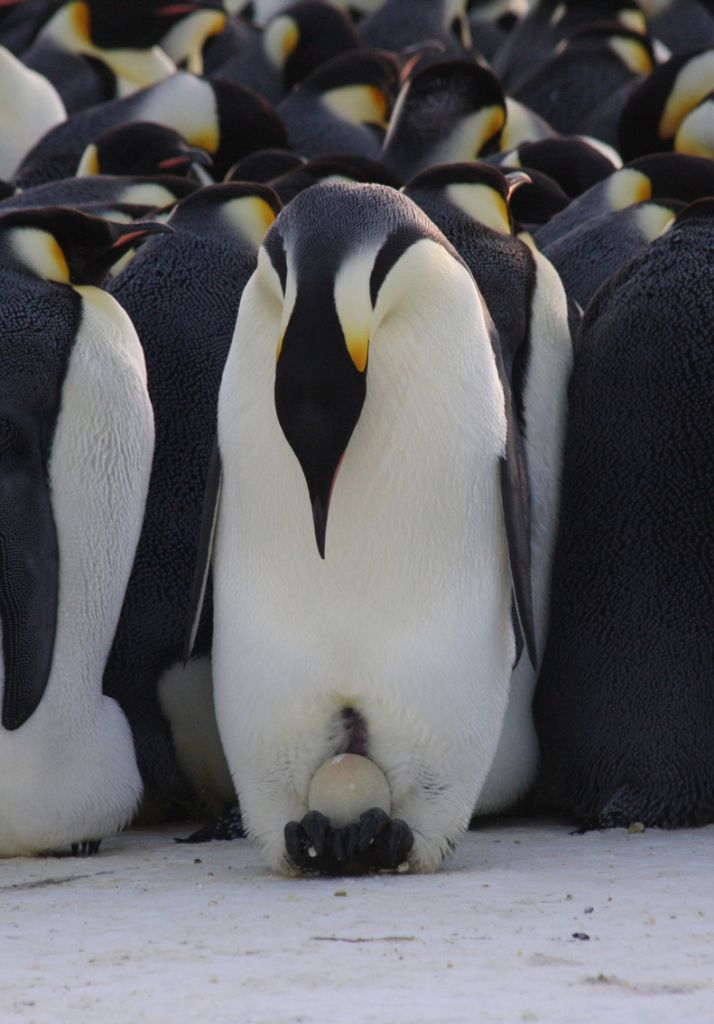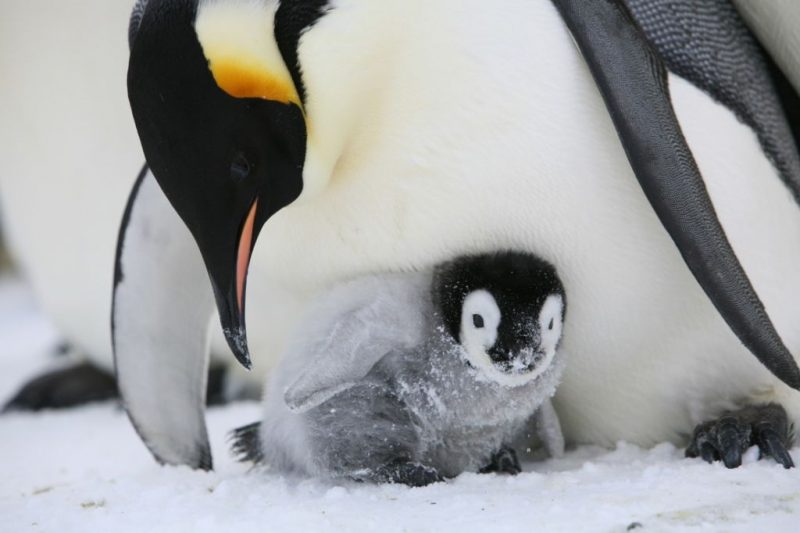

Male emperor penguin incubating an egg just prior to hatching in mid-July. Photo via Robyn Mundy/Australian Antarctic Division.
During the summer in the Southern Hemisphere – from about December to February – emperor penguins in Antarctica are at sea fattening up on squid, fish, and krill. As autumn approaches in March, the emperors leave the water and begin a long trek to one of several breeding colonies. The breeding cycle begins around now – the month of April, autumn in Antarctica – when penguins mate on the reforming sea ice. Each female produces a single egg. She transfers the egg to her mate, then leaves to spend winter in the open ocean.
During Antarctica’s winter – a frigid night four months long – male emperor penguins huddle by the hundreds in the snow. The male penguins guard the eggs and keep them warm. Each male penguin puts his egg on his feet. He covers it with a fold of skin. In this way, he keeps it warm at about 100 degrees Fahrenheit (38 degrees Celsius) while the outside temperatures can drop well below -30 degrees F (?35 degrees C).
For 65 days, each bird incubates an egg, huddled in large colonies with only feathers, fat, and each other to stay warm. The eggs may begin to hatch in July, but the male penguins’ winter vigil won’t end until around August when the sun peeks over the horizon.
By the time the female returns, sleek and full of food, the male may have lost 45 percent of his body weight. Ravenously hungry, he leaves to feed at sea. The offspring grow rapidly in summer when food at sea is plentiful. By December, the chicks are on their own.
Five years from now, if they survive in their ocean home, the young penguins will return to become parents themselves.
Read more: Emperor penguin breeding cycle

Emperor penguin chick. Photo via Gary Miller/Australian Antarctic Division.
Bottom line: The story of male emperor penguins, who sit for a long winter on their eggs.
from EarthSky http://bit.ly/2ZA6QjS


Male emperor penguin incubating an egg just prior to hatching in mid-July. Photo via Robyn Mundy/Australian Antarctic Division.
During the summer in the Southern Hemisphere – from about December to February – emperor penguins in Antarctica are at sea fattening up on squid, fish, and krill. As autumn approaches in March, the emperors leave the water and begin a long trek to one of several breeding colonies. The breeding cycle begins around now – the month of April, autumn in Antarctica – when penguins mate on the reforming sea ice. Each female produces a single egg. She transfers the egg to her mate, then leaves to spend winter in the open ocean.
During Antarctica’s winter – a frigid night four months long – male emperor penguins huddle by the hundreds in the snow. The male penguins guard the eggs and keep them warm. Each male penguin puts his egg on his feet. He covers it with a fold of skin. In this way, he keeps it warm at about 100 degrees Fahrenheit (38 degrees Celsius) while the outside temperatures can drop well below -30 degrees F (?35 degrees C).
For 65 days, each bird incubates an egg, huddled in large colonies with only feathers, fat, and each other to stay warm. The eggs may begin to hatch in July, but the male penguins’ winter vigil won’t end until around August when the sun peeks over the horizon.
By the time the female returns, sleek and full of food, the male may have lost 45 percent of his body weight. Ravenously hungry, he leaves to feed at sea. The offspring grow rapidly in summer when food at sea is plentiful. By December, the chicks are on their own.
Five years from now, if they survive in their ocean home, the young penguins will return to become parents themselves.
Read more: Emperor penguin breeding cycle

Emperor penguin chick. Photo via Gary Miller/Australian Antarctic Division.
Bottom line: The story of male emperor penguins, who sit for a long winter on their eggs.
from EarthSky http://bit.ly/2ZA6QjS

Aucun commentaire:
Enregistrer un commentaire